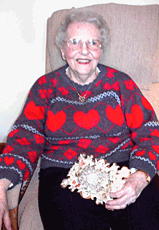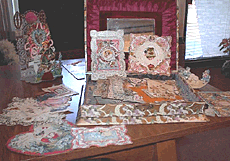|
How
I love, none can tell,
Dearest,
let me tell thee so;
Cherish
neither doubt or fear,
Trust
me thou alone art dear.
Scrawled
in pencil on the back are the words: "Pleas give this to your
little Friend Miss Dasey as I don’t know her other name."
The
recipient’s daughter laughs at the singular love expressed for a
person barely known. "We didn’t pay much attention to what
(valentines) said," explains Edith Norman Lawrence, who has
lived at the Christian Village in Lincoln since 1994. "If we
thought they were pretty, we bought them."

[Photos by Lynn Shearer Spellman]
Lawrence,
usually called Edie now, is 91, and the valentine recipient was her
mother, Daisy Swartz Norman, born in 1883. A native of Chicago who
moved to Lincoln from Hinsdale, Lawrence treasures a collection of
about 100 antique valentine cards, most given to her or her mother.
They range from 2½ to 11 inches tall, and many of the older,
Victorian ones have multiple overlays of lace paper, satin flowers
and glossy cutouts. Cherubs and angels, floral bouquets, romantic
scenes and chubby-cheeked children abound.
Lawrence
remembers a friend’s receiving a satin-topped valentine so large
she thought it was a box of candy. That came from a boyfriend, but
many of the sentimental cards were sent from one girl to another. In
fact, Edie Lawrence recalls that up to about seventh-grade she and
her friends sent valentines mostly to girlfriends. "We didn’t
grow up quite as fast in those days as the kids do now," she
explained.
She
has valentine postcards with 1 and 2 cents postage and envelopes
with 2 and 4 cents, but many valentines were hand-delivered. They
were always signed on the back so as not to mar the beautiful card.
Those placed in the valentine box at school named recipient as well
as sender.
Lawrence
recalls an ornate valentine box in each classroom. Some of her class’s
most beautiful boxes were made by her maternal grandmother, Frances
Marian Collings Swartz, an artist who painted china plates as well
as landscapes and portraits in water colors or oils.

To
ensure that each child received at least one valentine, the teacher
had students draw names and give to the child they drew. Of course,
they were free to give to as many other children as they wanted.
Lawrence said her mother made her give to everyone, "but other
mothers weren’t that fussy."
Lawrence
met her own valentine, her husband, Dick, at a high-school reunion
the Christmas following her graduation. She and her friends found
the party dull, with no one paying attention to them, and were about
to leave when she saw a man with dark brown eyes smiling at her. Her
friends left but she stayed, danced with Dick Lawence and enjoyed
the rest of the party with him and his friend Art Wiehe, whom she
vaguely knew. Neither man owned a car, so they escorted her home on
the bus.
Christmas
week passed with no phone call. "I was just crushed," Edie
Lawrence remembers. It turned out that Dick, a recent Ohio State
graduate, had just begun a job at Western Electric and was flat
broke. He spent the Christmas holidays with Wiehe’s family and
then called Edie in time for New Year’s Eve. Within a few months
she had an engagement ring.
Lawrence’s
daughter, Nancy Gehlbach of rural Lincoln, recalls that her mother’s
valentines to her father were always funny; his to her were always
mushy and often accompanied by a pretty nightgown. "He was a
very sentimental man, really," Edie Lawrence confirms.
After
Dick’s death on Feb. 3, 1983, Edie found that year’s valentine,
already bought and signed, in her walk-in closet. [to top of second column in this
article]
|

Gehlbach
recalls that her mother always made a big deal about decorating for
Valentine’s Day as well as other holidays. One year Nancy was
forbidden to enter the dining room for about an hour ahead of time.
Of course, this prohibition doubled her anticipation. The valentine
cake was usually angel food with white frosting decorated with red
cinnamon hearts. Heart doilies and glowing candles gave a festive
look.
Lawrence
said she sends valentines to Nancy and to her son, Norman Lawrence
of Aurora, and her five grandchildren. She especially enjoys
choosing cards for great-grandchildren Emma Gehlbach, Tyler Knudson,
and Hannah and Hayden Kovarik. She has sent funny and sweet
valentines but never sent or received the nasty kind.
Gehlbach,
who is researcher and writer for local history newsletter Our Times,
has studied the development of valentine cards in America. She
confirmed that comic valentines, some of which were "venomous
and cruel," accounted for half the sales by 1847. Their average
price, however, was less than for the "sentimentals." Some
were so cruel that they were sent unsigned.
A
Feb. 13, 1906 article in the Lincoln Times-Courier reported that the
price of the "homely creations" — in other words, the
nasty valentines — had fallen from two for a nickel to one or two
for a penny. The article continued: "Their decline in favor has
been equally marked as their decline in price, few people sending
them this year unless they send them in fun to people whom they know
will take them in the spirit they are sent."
Gehlbach
said there were distinct changes in valentines around 1850 and again
at the beginning of the 20th century. The earliest
valentines were handmade, but by mid-19th century many
were lithographed and then colored by hand. Often a space was left
for an original message, and books were published to help in
composing appropriate sentiments.
The
first American to run an assembly line of card-makers was Esther
Howland, who received an English valentine in 1847 and set out to
make similar ones. According to Gehlbach, Howland began with
"blanks," or lace-edged or embossed folders from England.
The center of some blanks was cut out and replaced with satin or
silk. On others the center was painted, or a picture or mirror was
glued there. Howland had different friends doing each job.
Gehlbach
said later valentines incorporated German-made pictures of flowers,
birds or other decorative subjects. Many were built in layers, with
folded strips of paper to make the additions stand out from the
blank.
In
the early 20th century the lace overlays began to
disappear. Increasingly important were novelties such as paper fans,
hanging valentines with multiple sections suspended by string, and
cards with built-in stands for display. Honeycomb valentines were
flat for mailing but opened out into three-dimensional hearts, bells
and other shapes. Lawrence has three of the honeycomb variety.
"We thought those were very special," she commented.

One
large manufacturer of early valentines was George C. Whitney. In
1915, according to Gehlbach’s sources, Whitney valentines ranged
from $1 to $50 in price. By the late 1920s the more expensive
designs had been eliminated and all the cards cost less than $5.
The
smaller Whitney valentines in Lawrence’s collection are about 4
inches tall, often heart-shaped and featuring chubby-cheeked
children. One depicts a toddler girl chasing a butterfly. There are
no lace overlays or other attachments. The verse, centered to fit
the middle of the heart shape, reads:
If
by chance you love me
Next
time you see me, smile!
I’ve
waited long to find this out
And still I’ll
wait awhile.
[Lynn
Shearer Spellman]
|

